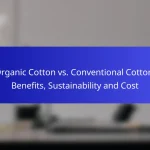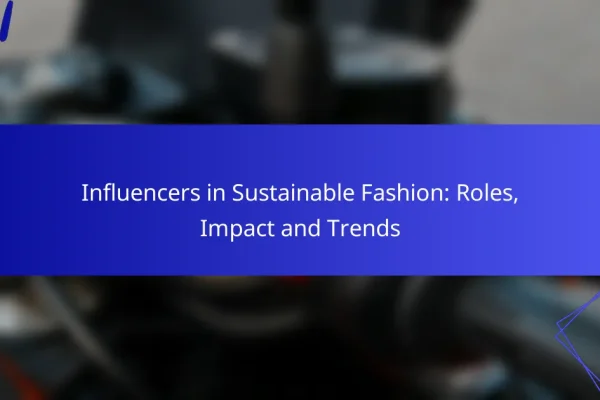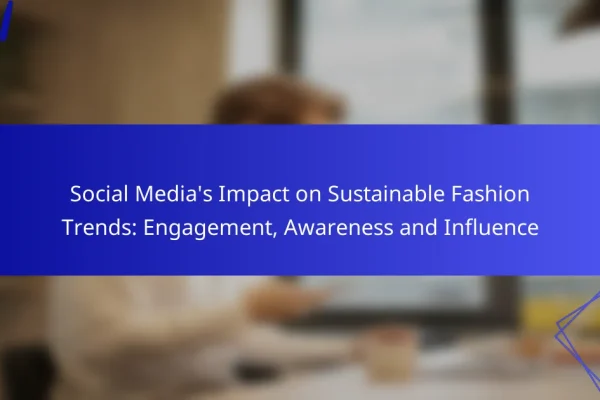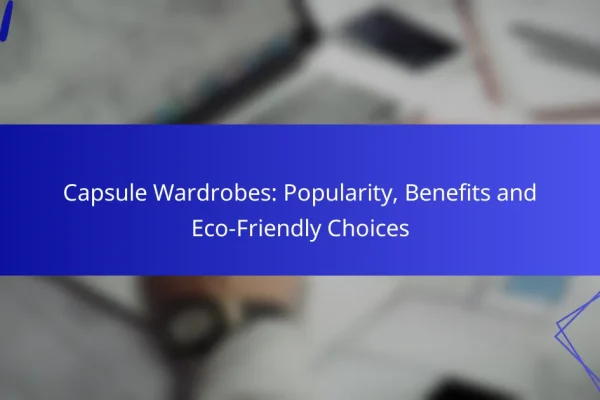What are the current sustainable fashion trends in the UK?
Current sustainable fashion trends in the UK focus on eco-friendly practices, innovative materials, and ethical production methods. Consumers are increasingly seeking brands that prioritize sustainability, which is reshaping the fashion landscape.
Eco-friendly materials
Eco-friendly materials are at the forefront of sustainable fashion, with brands opting for organic cotton, Tencel, hemp, and recycled fabrics. These materials reduce environmental impact by minimizing water usage and chemical treatments. For instance, organic cotton uses about 88% less water compared to conventional cotton.
When choosing clothing, look for certifications like GOTS (Global Organic Textile Standard) or OEKO-TEX, which indicate responsible sourcing and production practices. This ensures that the materials used are not only sustainable but also safe for consumers.
Upcycling and recycling
Upcycling and recycling are gaining traction as consumers look to extend the life cycle of garments. Upcycling involves creatively transforming old clothing into new items, while recycling focuses on breaking down textiles to create new fabrics. Brands like Reformation and Elvis & Kresse exemplify this trend by turning waste into fashionable products.
To participate in this trend, consider donating or selling your old clothes instead of discarding them. You can also explore DIY projects to upcycle items at home, which can be both fun and environmentally friendly.
Minimalist fashion
Minimalist fashion emphasizes simplicity and versatility, encouraging consumers to invest in fewer, high-quality pieces that can be mixed and matched. This approach not only reduces waste but also promotes a more thoughtful consumption pattern. Capsule wardrobes, which consist of a limited number of essential items, are a popular way to adopt this trend.
When building a minimalist wardrobe, focus on timeless styles and neutral colors that can be easily paired. Aim for items that are durable and made from sustainable materials to ensure longevity.
Slow fashion movement
The slow fashion movement advocates for a more deliberate approach to clothing production and consumption. It encourages consumers to buy less and choose quality over quantity, often supporting local artisans and ethical brands. This movement aims to combat the fast fashion cycle that leads to excessive waste and exploitation.
To embrace slow fashion, consider researching brands that prioritize ethical practices and transparency in their supply chains. Supporting local markets and second-hand shops can also contribute to a more sustainable fashion ecosystem.
How are brands implementing sustainable practices?
Brands are increasingly adopting sustainable practices by focusing on eco-friendly materials, ethical labor, and transparent supply chains. These initiatives aim to reduce environmental impact while promoting social responsibility within the fashion industry.
Patagonia’s environmental initiatives
Patagonia is a leader in sustainable fashion, known for its commitment to environmental conservation. The brand uses recycled materials in its products and actively supports various environmental causes through its 1% for the Planet program, donating a portion of sales to grassroots organizations.
Additionally, Patagonia encourages customers to repair and recycle their clothing through initiatives like the Worn Wear program, which promotes the longevity of garments and reduces waste.
Everlane’s transparency model
Everlane has built its brand around transparency, providing detailed information about the costs of production and the ethical practices involved in creating its products. Each item includes a breakdown of materials, labor, and transportation costs, allowing consumers to understand the true value of what they purchase.
This model not only fosters trust but also encourages responsible consumer behavior by highlighting the importance of ethical sourcing and fair labor practices in the fashion industry.
Reformation’s sustainable collections
Reformation focuses on creating stylish clothing using sustainable materials and practices. The brand prioritizes eco-friendly fabrics such as Tencel and recycled polyester, which significantly reduce water usage and carbon emissions compared to traditional materials.
Reformation also tracks its environmental impact through a detailed sustainability scorecard for each product, helping customers make informed choices while promoting awareness of sustainable fashion practices.
What are the benefits of sustainable fashion?
Sustainable fashion offers numerous benefits, including reduced environmental impact, support for ethical labor practices, and the promotion of a circular economy. By prioritizing eco-friendly materials and ethical production methods, sustainable fashion contributes to a healthier planet and fairer working conditions.
Reduced environmental impact
Sustainable fashion significantly lowers the environmental footprint of clothing production. This includes using organic materials, minimizing water consumption, and reducing carbon emissions. For instance, brands that utilize recycled fabrics can cut down on waste and energy usage compared to traditional manufacturing methods.
Consumers can also make a difference by choosing brands that prioritize sustainability. Look for certifications such as Global Organic Textile Standard (GOTS) or OEKO-TEX, which indicate environmentally friendly practices. Additionally, opting for second-hand clothing can further decrease demand for new production.
Support for ethical labor practices
Ethical labor practices are a cornerstone of sustainable fashion, ensuring fair wages and safe working conditions for garment workers. Many sustainable brands are transparent about their supply chains and actively work to improve labor conditions. This commitment helps combat exploitation and supports local economies.
When shopping, consider brands that provide information about their labor practices and certifications like Fair Trade. Supporting these companies not only promotes ethical standards but also encourages the industry to adopt better practices overall.
Promotion of circular economy
The circular economy is a model that emphasizes reusing and recycling materials to extend the lifecycle of products. In sustainable fashion, this means designing clothes that can be easily repaired, reused, or recycled. Brands that embrace this model often take back old garments for recycling or repurposing.
Consumers can contribute by choosing high-quality items that last longer and by participating in clothing swaps or recycling programs. This approach not only reduces waste but also fosters a culture of sustainability within the fashion industry.
How to choose sustainable fashion brands?
Choosing sustainable fashion brands involves looking for specific indicators that demonstrate their commitment to environmental and ethical practices. Focus on certifications, transparency, and material sourcing to make informed decisions.
Look for certifications like GOTS
Certifications such as the Global Organic Textile Standard (GOTS) are essential in identifying sustainable fashion brands. GOTS ensures that textiles are made from organic fibers and adhere to strict environmental and social criteria throughout the production process.
When shopping, check for labels that display GOTS certification or similar standards. This can help you avoid brands that engage in greenwashing, where they claim to be sustainable without meeting rigorous criteria.
Research brand transparency
Brand transparency is crucial for understanding a company’s sustainability practices. Look for brands that openly share information about their supply chain, production methods, and labor practices.
Visit the brand’s website or third-party platforms to find detailed reports on their sustainability efforts. Brands that are willing to disclose their practices are often more committed to genuine sustainability.
Evaluate material sourcing
Assessing how a brand sources its materials is key to determining its sustainability. Look for brands that use organic, recycled, or upcycled materials, which have a lower environmental impact compared to conventional fabrics.
Additionally, consider the lifecycle of the materials used. Brands that prioritize sustainable sourcing often provide information on the environmental footprint of their products, helping you make better choices.
What are the challenges in sustainable fashion?
Sustainable fashion faces several challenges that hinder its widespread adoption. Key issues include higher production costs, the need for consumer awareness and education, and complex supply chain logistics.
Higher production costs
One of the main challenges in sustainable fashion is the higher production costs associated with eco-friendly materials and ethical labor practices. Brands often pay more for organic fabrics and fair wages, which can lead to retail prices that are significantly higher than fast fashion alternatives.
Consumers may be hesitant to pay these elevated prices, even though they reflect the true cost of sustainable practices. Brands must find ways to communicate the value of sustainability to justify these costs.
Consumer awareness and education
Another challenge is the lack of consumer awareness regarding sustainable fashion practices. Many shoppers are not fully informed about the environmental and social impacts of their clothing choices, which can lead to indifference toward sustainable options.
Brands can address this by investing in educational campaigns that highlight the benefits of sustainable fashion, such as reduced environmental impact and support for ethical labor. Engaging storytelling and transparency about sourcing can also help increase consumer interest.
Supply chain complexities
The supply chain for sustainable fashion is often more complex than that of conventional fashion. Sourcing sustainable materials can involve multiple suppliers, each with their own practices and standards, making it difficult to ensure compliance with sustainability goals.
Brands need to establish strong relationships with suppliers and implement rigorous tracking systems to maintain transparency. Simplifying the supply chain where possible can help mitigate these complexities and improve overall sustainability.










